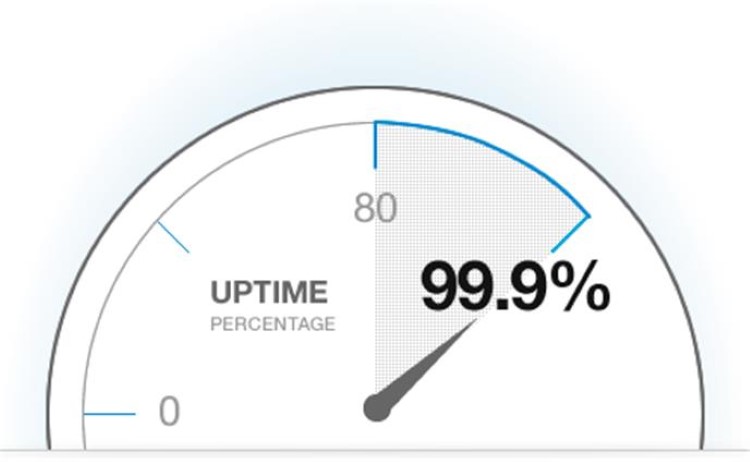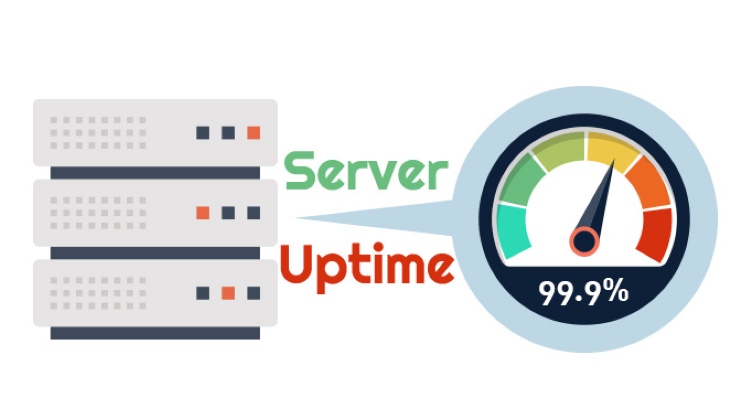Heard the term ‘uptime’ thrown around when discussing websites, servers, or hosting plans? It might sound technical, but the basic idea is simple: uptime is the measurement of how long your service (like a website or server) is operational and available to users. This core concept is vital for anyone online.
If you’re wondering exactly what that means, why it’s crucial for your online presence, and how to make sense of terms like “99.9% uptime guarantee,” you’ve come to the right place. This guide will clearly explain the definition of uptime, explore why high uptime is essential, and demystify those important percentage figures. Let’s dive in!
What is Uptime?
At its heart, uptime refers to the period your website, server, or network is functioning correctly and accessible to its intended users. Think of it like a physical store being open for business; if the doors are open and customers can come in, the store has uptime.
When your website is “up,” visitors can browse pages, use features, and interact with your content without issues. This operational status is the essence of uptime. It’s the opposite of downtime, which we’ll discuss later. Uptime signifies availability and functionality online.
The concept applies broadly across technology. Server uptime means the server hardware and operating system are running. Network uptime indicates the network infrastructure connecting users to services is operational. Application uptime means specific software is working as expected for users accessing it.
Essentially, if someone can use the service as intended, it is experiencing uptime. This simple idea has significant implications, making it a critical metric. Understanding this basic uptime definition is the first step towards appreciating its overall importance in the digital world.
For example, when you visit your favorite news website and can read articles, that site is experiencing uptime. If your company uses cloud-based email and employees can send and receive messages, that email service has uptime. It’s about consistent accessibility.

Why is Uptime So Important?
High uptime isn’t just a technical goal; it’s fundamental to online success because it directly impacts user trust, visibility, and potential revenue. When your service is consistently available, it builds a positive foundation for nearly every aspect of your digital presence and operations.
Imagine trying to visit an online shop, only to find it repeatedly closed or inaccessible. You’d likely get frustrated and take your business elsewhere. Consistent uptime is crucial for keeping your audience engaged and satisfied, forming the bedrock of a reliable online experience for everyone.
Let’s break down the specific areas where uptime plays a critical role:
Impact on User Experience & Trust
First impressions matter online. Consistent uptime ensures visitors have a smooth, positive experience, which builds trust and encourages return visits. When users can rely on your website or service being available whenever they need it, they perceive your brand as dependable and professional.
Conversely, frequent downtime creates frustration. If a user tries to access your site and encounters errors or loading failures, they may assume your site is unreliable or even abandoned. This negative experience can quickly drive them to competitors offering a more stable platform.
Think about accessing your online banking portal. You expect it to be available 24/7. If it were frequently down, you’d lose trust in the bank’s ability to manage your finances securely and reliably. The same principle applies to any online service people depend on.
Building user trust is paramount online. High website availability is a non-negotiable part of that equation. It signals professionalism and respect for the user’s time, making them more likely to engage, convert, or return in the future, enhancing overall customer satisfaction levels.
Effect on SEO Rankings
Search engines like Google aim to provide users with the best possible results, and that includes reliable websites. Frequent or prolonged downtime can negatively signal search engine crawlers, potentially harming your site’s search rankings over time. Accessibility is a key factor.
Googlebot and other crawlers need to access your site to index its content. If they repeatedly encounter errors because your server is down, they can’t see your pages. This can lead to pages being temporarily dropped from the index or ranked lower than more reliable competitors.
While occasional brief downtime might not have a major impact, persistent availability issues tell search engines your site offers a poor user experience. Google explicitly mentions site speed and usability as ranking factors; chronic downtime fundamentally undermines both of these important considerations.
Therefore, maintaining high server uptime is part of good technical Search Engine Optimization (SEO). It ensures search engines can consistently access and evaluate your content, supporting your efforts to achieve and maintain visibility in search results pages (SERPs) for relevant queries.
Connection to Business Revenue & Reputation
For many businesses, especially e-commerce sites or those relying on online leads, uptime is directly linked to revenue generation. Every minute your website is down can translate into lost sales, missed opportunities, and reduced customer acquisition, impacting the bottom line significantly.
Consider an online store during a major holiday sale. If the website crashes due to high traffic or technical issues (experiencing downtime), potential customers cannot make purchases. This results in immediate lost revenue and potentially long-term customer loss due to the poor experience offered.
Beyond direct sales, downtime damages your brand’s reputation. News of significant outages can spread quickly on social media, portraying your business as unreliable. Rebuilding that reputation takes considerable time and effort, often costing more than preventing the downtime initially would have.
Studies consistently show the high cost of downtime. Depending on the business size and industry, unplanned outages can cost thousands, even millions, of dollars per hour. Investing in reliable hosting and infrastructure to maximize uptime is therefore a critical business decision, safeguarding revenue streams.
Furthermore, internal systems also rely on uptime. If a company’s internal project management tool or communication platform goes down, employee productivity plummets. This demonstrates that uptime’s importance extends beyond customer-facing services to internal operational efficiency and overall business continuity planning.
How is Uptime Measured? (Understanding the Percentages)
Uptime is most commonly expressed as a percentage, representing the proportion of time a service was operational within a given period (like a month or year). This standardized measurement allows for easy comparison between different hosting providers or service level agreements, offering a quantifiable metric.
The calculation is straightforward: (Total time – Downtime) / Total time * 100%. For instance, if a server was down for 1 hour in a 720-hour month, the uptime is (720 – 1) / 720 * 100% = 99.86%. This percentage provides a snapshot of reliability.
Hosting providers and service vendors often advertise their uptime percentages prominently. You’ll frequently see figures like 99%, 99.9%, or even 99.99%. While these numbers look similar, the small differences represent significant variations in actual service availability over time periods.
Understanding these percentages is key to evaluating hosting plans or service contracts. It helps set realistic expectations about potential service interruptions. Let’s explore the most common way these percentages are discussed – using “the nines” notation for clarity and impact.

The Famous “Nines” Explained (99%, 99.9%, 99.99%)
The term “nines” refers to the number of nines present in the uptime percentage figure. Each additional nine represents a tenfold increase in guaranteed availability, meaning significantly less potential downtime. This shorthand is widely used in the hosting and IT industry.
- 99% Uptime (“Two Nines”): This sounds high, but it allows for roughly 7 hours and 18 minutes of downtime per month, or over 3.65 days per year. For many critical applications or businesses, this level of potential disruption is unacceptable.
- 99.9% Uptime (“Three Nines”): This is often considered a minimum standard for professional web hosting. It translates to about 43 minutes of downtime per month, or approximately 8.76 hours per year. A significant improvement over two nines.
- 99.99% Uptime (“Four Nines”): This level indicates very high reliability, permitting only about 4 minutes and 20 seconds of downtime per month, or just under 53 minutes per year. Often sought for e-commerce and important business applications.
- 99.999% Uptime (“Five Nines”): Considered the gold standard for critical systems (like telecommunications or financial services), allowing for merely 26 seconds of downtime per month, or just over 5 minutes per year. Achieving this requires robust infrastructure.
Understanding the nines helps contextualize uptime guarantees. A provider offering 99.99% uptime is making a much stronger commitment to reliability than one offering 99% uptime. Always check the specifics of any guarantee being offered by vendors.
Calculating Potential Downtime (Putting Percentages in Perspective)
While percentages are standard, translating them into actual time units makes the impact clearer. Calculating the potential downtime associated with an uptime percentage reveals the real-world implications of service availability promises. This helps visualize the risk involved.
Here’s a breakdown of potential downtime per year and per month for common uptime percentages:
| Uptime % | “Nines” | Max Downtime per Year | Max Downtime per Month (approx.) |
|---|---|---|---|
| 99% | Two | 3.65 days | 7 hours 18 minutes |
| 99.5% | – | 1.83 days | 3 hours 39 minutes |
| 99.9% | Three | 8.76 hours | 43 minutes 49 seconds |
| 99.95% | – | 4.38 hours | 21 minutes 55 seconds |
| 99.99% | Four | 52.56 minutes | 4 minutes 23 seconds |
| 99.999% | Five | 5.26 minutes | 26.3 seconds |
Note: Monthly calculations assume an average month length of 30.44 days.
Seeing these figures highlights how crucial even fractions of a percentage point are. What seems like a minor difference (e.g., 99.9% vs 99.99%) actually represents a tenfold difference in allowed service interruption over the course of a year or month.
This perspective is vital when choosing a hosting provider or evaluating service contracts. Consider your specific needs: can your website or application tolerate several hours of downtime per year (99.9%), or do you require near-constant availability (99.99% or higher)?
Uptime vs. Downtime: What’s the Difference?
The relationship between uptime and downtime is simple: they are direct opposites. Uptime is the duration a system is operational and available, while downtime is the period it is non-operational or inaccessible to users trying to reach it.
Think of it like a light switch. Uptime is when the light is ‘on’ (the service works). Downtime is when the light is ‘off’ (the service is unavailable). The total time is always the sum of the uptime and the downtime experienced within that period.
Downtime can be categorized generally into two types:
- Scheduled Downtime: This is planned maintenance announced in advance. Activities like server upgrades, security patching, or hardware replacements might require temporarily taking systems offline. Providers usually schedule this during low-traffic hours.
- Unplanned Downtime: This is unexpected disruption caused by unforeseen events like hardware failure, software bugs, network outages, power failures, security incidents (like DDoS attacks), or human error. This type is far more disruptive and damaging.
While scheduled downtime is often necessary for system health, providers aim to minimize it. Unplanned downtime is what uptime guarantees primarily aim to protect against. Both contribute to the total downtime used in uptime percentage calculations mentioned earlier.
Understanding this distinction is important when interpreting uptime reports or SLA details. Some agreements might exclude scheduled maintenance from their uptime calculation, so always read the fine print carefully to know exactly what is being guaranteed by the provider.
What is an Uptime Guarantee (SLA)?
An uptime guarantee is a commitment, usually formalized in a Service Level Agreement (SLA), where a service provider promises a minimum level of uptime (e.g., 99.9%) over a specific period. This provides customers with assurance about service reliability expectations.
An SLA (Service Level Agreement) is a contract outlining the specific services a provider will deliver, the performance standards they must meet (including uptime), and the remedies or penalties if those standards are not met. It defines the relationship clearly.
These guarantees are common in web hosting, cloud computing, and other IT service industries. They give customers a benchmark for expected performance. If the provider fails to meet the guaranteed uptime percentage, the SLA typically entitles the customer to compensation.
Compensation often comes in the form of service credits – discounts on future bills. The amount usually depends on the severity and duration of the downtime relative to the guarantee. For example, dropping below 99.9% might earn a 5% credit, while dropping below 99% could earn a larger credit.
It’s crucial to read the SLA document carefully. Understand how uptime is calculated, what constitutes downtime (are scheduled maintenance periods excluded?), how to report downtime, and the exact process for claiming credits if the guarantee is breached by the service provider.
While an SLA provides recourse, it doesn’t prevent downtime entirely. Its main purpose is to set clear expectations and offer compensation if reliability falls short. Choosing a provider with a strong SLA and a good historical track record for uptime is always recommended practice.
Think of the SLA as insurance for service availability. It doesn’t stop problems but provides a defined remedy if they occur. Providers offering strong SLAs are often more confident in their infrastructure’s reliability, which can be a positive indicator for potential customers.
What Factors Can Affect Uptime? (A Brief Overview)
Maintaining high uptime requires managing various potential points of failure. Multiple factors, ranging from physical hardware issues to software glitches and external events, can negatively impact server, website, or network uptime. Awareness helps in mitigation planning.
Here’s a brief look at common causes of downtime:
- Hardware Failures: Physical components like hard drives, RAM, power supplies, or network cards can malfunction or fail entirely. Redundant hardware (e.g., RAID for disks, multiple power supplies) helps mitigate this risk significantly but adds cost.
- Software Issues: Bugs in the operating system, web server software (like Apache or Nginx), databases, or website code itself can cause crashes or instability leading to downtime. Regular patching and testing are essential software maintenance practices.
- Network Problems: Issues beyond the server itself, such as problems with routers, switches, internet service provider (ISP) outages, or DNS (Domain Name System) failures, can make a perfectly functional server inaccessible to users online.
- Security Incidents: Malicious attacks like Distributed Denial of Service (DDoS) aim specifically to overwhelm a server or network, causing downtime. Viruses, malware, or unauthorized access can also disrupt service availability significantly without proper defenses.
- Human Error: Mistakes during configuration changes, maintenance procedures, or software deployment can inadvertently cause systems to go offline. Proper protocols, training, and automation help minimize risks associated with human intervention or oversight.
- Environmental Factors: Events like power outages, fires, floods, or cooling system failures in a data center can physically damage equipment or force shutdowns, leading to significant downtime if disaster recovery plans aren’t robust.
- Resource Exhaustion: Unexpectedly high website traffic (like going viral) or runaway processes can consume all available server resources (CPU, RAM, bandwidth), causing slowdowns or complete unresponsiveness, effectively resulting in downtime for users.
Reliable hosting providers invest heavily in redundancy (backup systems), monitoring tools, security measures, robust data center facilities, and skilled staff to proactively manage these factors and minimize the chances of unplanned downtime impacting customer services directly.

Key Takeaways: What You Need to Remember About Uptime
Understanding uptime is essential for anyone managing or relying on online services. It’s a cornerstone of reliability in the digital world. Let’s recap the most important points covered in this comprehensive guide:
- Definition: Uptime is the time your service (website, server, application) is operational and accessible to users. It’s the opposite of downtime.
- Importance: High uptime builds user trust, supports SEO efforts, protects business revenue, and maintains brand reputation. It’s crucial for success.
- Measurement: Uptime is typically measured as a percentage (e.g., 99.9%), often discussed using “nines.” Higher percentages mean significantly less potential downtime.
- Context is Key: Translate percentages into actual downtime (minutes/hours per month/year) to grasp their real-world impact on availability.
- SLA Significance: An Uptime Guarantee within an SLA is a provider’s commitment to a minimum level of availability, often offering credits if not met.
- Multiple Causes: Downtime can result from hardware failures, software bugs, network issues, security attacks, human error, and more factors.
Ultimately, prioritizing uptime means choosing reliable service providers, understanding guarantees, and recognizing the profound impact availability has on your users and your goals. Whether you run a personal blog or a large e-commerce platform, consistent uptime is fundamental to a positive online presence.
We hope this explanation has clarified what uptime means and why it’s such a vital metric in today’s connected world. Keep these concepts in mind when evaluating hosting options or managing your own online infrastructure for optimal performance.
